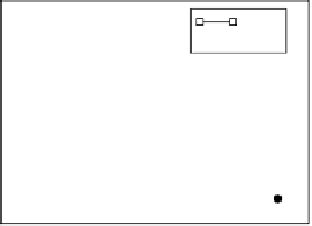Information Technology Reference
In-Depth Information
Stroop Data (Dunbar & MacLeod, 84)
Color Conf
Color Cong
Word Conf
Word Cong
900
Color
Word
800
Stroop SOA (Glaser & Glaser, 82)
700
700
650
600
600
500
550
Control
Conflict
Congruent
500
Condition
450
Figure 11.3:
Reaction times for standard Stroop task, show-
ing strong interference effect in the color naming conflict con-
dition, and little effect of color on word reading. The control
conditions have no influence from the other process (i.e., just
reading a color word written in black ink, or naming a patch
of color or colored X's). In the conflict condition, color and
word conflict (e.g., “red” written in green ink), and in the con-
gruent condition they agree. Data from Dunbar & MacLeod,
1984.
400
−400
−200
0
200
400
SOA
Figure 11.4:
Reaction time data from a Stroop task where
colors and words were presented at different times relative to
each other (stimulus onset asynchrony, SOA). For word read-
ing negative SOA means the color preceded the word. For
color naming, negative SOA means the word preceded the
color. Even when presented 400 msec before the word, color
fails to significantly affect word reading, invalidating the pro-
cessing speed model. Data from Glaser & Glaser, 1982.
Dunbar & MacLeod, 1984). There are several impor-
tant features of these data: (a) the relative weakness of
the color naming process is revealed by slower overall
reaction times; (b) the color naming conflict condition
is particularly slowed, because the conflicting prepotent
word reading response must be overcome; (c) there is
a slight facilitation effect for congruent stimuli in the
color naming condition (color and word the same) com-
pared to the control condition where no other informa-
tion is present (e.g., naming a color patch or colored
X's); (d) the relative automaticity of word reading is ev-
ident by virtue of its imperviousness to the color condi-
tion — reaction times are essentially flat across condi-
tions (though there are small effects that are consistent
with the conditions).
One standard account of the Stroop effect is in terms
of processing speed — word reading is faster, and thus
drives the response before the color information is pro-
cessed, explaining the lack of effect of color on word
reading. Color naming, being slower, must overcome
the word reading response which is already influencing
the response.
Glaser and Glaser (1982) independently varied the on-
set of color and word information (i.e., the stimulus on-
set asynchrony, or SOA). If the processing speed ac-
count is correct, presenting the color prior to the word
should result in color interfering with word reading.
However, as shown in figure 11.4, this was not the ob-
served result — color still had virtually no effect on
word reading even when presented 400 msec prior to
the word.
Thus, as argued by Cohen et al. (1990), a strength-
based account, where the word-reading pathway is
stronger than the color-naming one and thus dominates
it in the context of competitive activation dynamics,
provides a better model of the Stroop effect. In the
model, the strength differences are due to learning,
which is sensitive to the differential frequencies of word
reading and color naming. Thus, the word reading path-
way has stronger, better-trained weights than the color
naming pathway. These differences result both in faster
To test this processing speed account,




















Search WWH ::

Custom Search